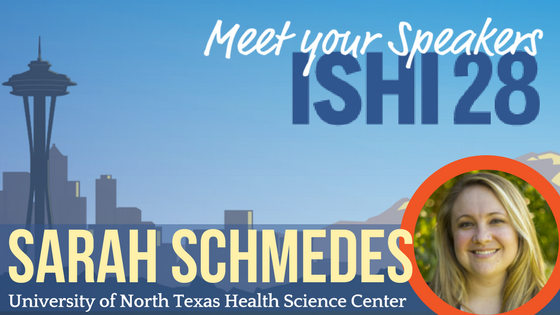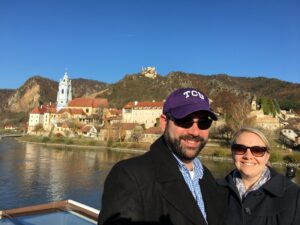The ISHI agenda is live and includes great talks from amazing speakers! While the forensic community is a tight-knit group, we can always get a little closer, right? With that in mind, we interviewed our speakers to preview their presentations and to get to know them a little better outside of their work. We’ve been posting their responses in a feature we like to call Under the Microscope.
Today, we’re chatting with Sarah Schmedes, who was a co-contributor on Forensic Human Identification using Targeted Clade-Specific Markers from Skin Microbiomes with Supervised Learning Classification, which will be presented during the General Sessions on Thursday, October 5th.
Can you please describe what the human microbiome is?
The human microbiome is the entire microbial population(s) on and in the human body. This includes microbial species from bacteria, archaea, viruses, and microbial eukaryotes. It is reported that microbial cells outnumber human cells 10:1, and the microbiome plays critical roles in metabolism, immune response, and health/disease states.
What is a “clade specific” marker?
A “clade-specific” marker is a genetic marker specific to a particular taxonomic clade (e.g., kingdom, phylum, class, order, family, genus, species, subspecies). For example, a clade-specific marker specific to the genus Staphylococcus would only be present in species and subspecies belonging to the genus, Staphylococcus.
How do you envision this technology being used in the future?
Given the advancements in massively parallel sequencing and rapid growth of microbial genome databases, I believe microbiome profiling applications will be instrumental in forensic labs to help produce investigative leads. Forensic microbial applications can include human identification, recent geolocation, as well as other trace evidence applications. I envision skin microbiome profiling to be implemented into the forensic workflow after further method development, validation, and interpretation criteria are established.
Were there any surprises that arose during the study?
I was surprised to see how well we could classify skin microbiomes from the hand to their particular host (up to 100%) given the nature of the hand. I expected there to be more interference from transient microorganisms from touching objects, shaking hands, washing hands, etc. and limit high classification accuracies.
What do you feel is the biggest challenge that forensics laboratories are facing today?
I believe the biggest challenge facing forensic laboratories today is implementing the newer technologies and standards into the lab. I believe this can be done, and soon, but many challenges hinder this implementation including funding, time and labor for validation studies, and consensus of standards to be implemented. Additionally, privacy concerns and/or differing laws and policies may hinder implementation in certain jurisdictions.
What do you think are likely to be the most exciting developments for the industry over the next couple of years?
I think the advancement of microbial forensics applications (i.e., human identification, post-mortem interval, geolocation, phenotypic/lifestyle, infection source tracking) and molecular autopsy will provide some of the most exciting developments for the forensic field. Advancements in molecular methods, especially massively parallel sequencing, allow us to gather more data than ever before to provide more evidence to help produce investigative leads.
What tips would you give to someone who is just starting out in the forensics field, or what’s the best advise you’ve ever received?
I have 3 tips I would give someone just starting out in the forensic field.
- Know what you’re getting into! Forensics is not the glamourous CSI TV show. Talk to a professional in the field to get an expectation of what the job is really like.
- Have a solid foundation in your scientific field. Forensic-specific courses are important, but you must have a solid foundation in your field. I would recommend an undergraduate degree in chemistry/biochemistry or biology/molecular biology if you would like to enter the forensic field as a forensic chemist or forensic biologist. You can always learn forensic applications or specialize with a master’s degree, but a solid foundation in biology/chemistry will go so much further.
- If you can’t find your “dream” job right away, do not be discouraged. Always take a job that will help build your training/skills to apply for the job you want in the future. Just be patient, gain experience, and eventually you will find that job. And you never know…you may end up down a path you never thought you’d go!
How did you become interested in forensics?
I first became interested in DNA profiling in freshman biology during my undergraduate studies when we extracted DNA from our own hair and visualized our specific band patterns on agarose gels. From that lab I fell in love with molecular biology. I remember gaining an interest in microbial forensics after the 2001 anthrax attacks, and I wanted to learn more about the human forensics and microbial forensics fields. So after many Google searches and graduate school applications, I found myself getting my master’s degree in Forensic Biology at UAlbany. I currently do research in both human and microbial forensics and love it!
When you’re not at work, what do you most enjoy doing?
When I’m not at work I enjoy baking and knitting, and when I am lucky enough to have time off, I love to travel! And I of course love spending time with my amazing husband and my dog, Bella!
For those who are on the fence about registering for the upcoming ISHI, please share your thoughts and reasons why they should attend.
ISHI has always been my favorite conference to attend. The event is organized so well, and I really enjoy networking with so many different professionals around the world. The topic areas and speakers are always well diversified to cover the newest studies relevant to casework as well as new up-and-coming technologies in research. The vendor showcases are very informative and fun to attend. And last but not least the food and social events are top notch!
WOULD YOU LIKE TO SEE MORE ARTICLES LIKE THIS? SUBSCRIBE TO THE ISHI BLOG BELOW!



